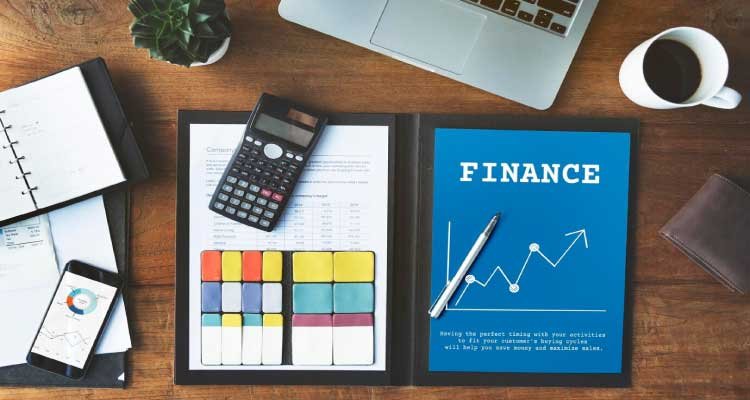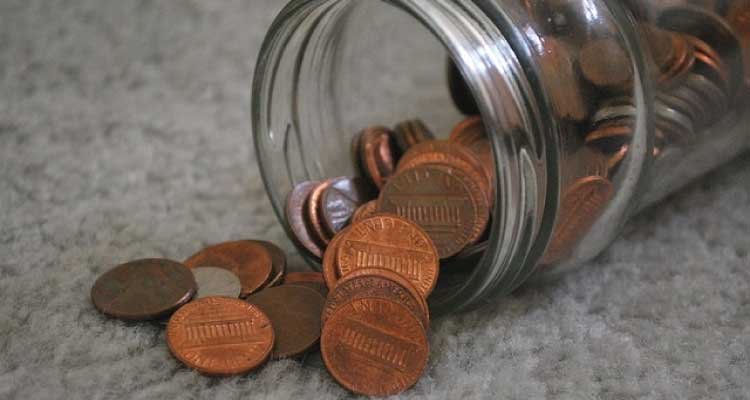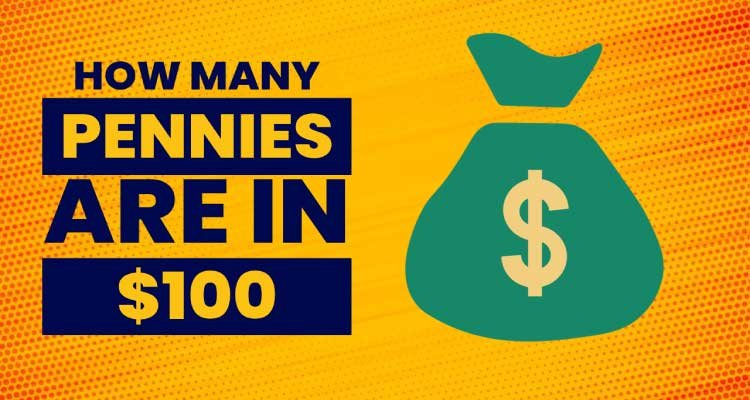How many pennies are in $100? Hmm! Well, let’s dive into the world of coin counting and discover just how many of those shiny copper treasures you’d need to reach that Benjamin Franklin milestone. Get ready to be amazed, folks!
Pennies, the unsung heroes of U.S. currency, play a crucial role in everyday transactions. As the smallest denomination of money in the United States, they’re often overlooked, but they’re more interesting than you might think.
What is a Penny and Its Brief History?
The penny, also known as the one-cent coin, is the smallest unit of currency in the United States. It’s like the foundation of the American monetary system. While it might not seem like much on its own, when you gather enough pennies, they can add up to substantial sums.
The history of the penny is a journey through time, starting way back in 1793. Over the years, its design has evolved, and it has been made from various materials, including copper, steel, and zinc. The Lincoln penny, featuring the 16th President of the United States, is perhaps the most well-known variation. These tiny copper-colored disks hold a piece of American history in the palm of your hand.
The Value of a Penny
In monetary terms, one penny is equivalent to 1/100th of a dollar. It’s the lowest denomination in the U.S. currency system. This means that if you have a hundred pennies, you have a dollar’s worth of coins. Keep this value in mind as we delve into the main question: How many pennies are in $100? It’s a question that might seem deceptively simple, but the answer can be quite intriguing.
Counting Pennies: A Simple Yet Rewarding Task
Counting pennies can be a relaxing and rewarding activity. While it may appear straightforward, there are some tricks and techniques that can make the process smoother.
Before counting your pennies, it’s essential to organize them. Many people use containers, jars, or coin wrappers to sort their pennies. This not only keeps your pennies tidy but also allows for easier counting in manageable quantities. For instance, placing 50 pennies into a roll makes it simple to keep track of how many dollars you’ve counted.
See: 42 Side Hustles That Pay Weekly
Tips for Efficient Penny Counting
When dealing with a large number of pennies, efficiency is key. Here are a few tips to make the process more manageable:
- Use a Coin Sorter: Coin sorting machines are widely available and can save you a lot of time. They automatically count and sort your coins, making the process incredibly efficient.
- Divide and Conquer: Break down the task into smaller portions. Counting 100 pennies at a time is much less daunting than tackling the entire pile all at once.
- Stay Organized: Keep your workspace organized to prevent miscounts and confusion. Separate the pennies into groups and label them as you go.
Different Methods of Penny Counting
Counting pennies isn’t just about doing simple math. People often employ different methods, depending on their preferences. Some enjoy the soothing rhythm of manually counting one by one, while others prefer technology’s assistance.
- Manual Counting: This traditional approach involves counting each penny individually, either in your hand or by placing them into small groups.
- Coin Counting Machines: These machines, often found in banks or supermarkets, accurately count and even exchange your pennies for bills. It’s a convenient option for those with a large collection.
- Online Apps: In the digital age, there are smartphone apps that can help you count your pennies efficiently. Simply take a photo of your coins, and the app will do the counting for you.
How Many Pennies Are in $100? A Simple Calculation

It’s time to answer the central question: “How many pennies are in $100?” The answer lies in the fundamental relationship between dollars and cents.
100 Pennies in a Dollar
Before we crunch the numbers, it’s essential to understand that there are 100 pennies in a single dollar. This is a straightforward conversion that forms the basis of the entire U.S. currency system.
The Calculation
To determine how many pennies are in $100, we can use the simple formula:
(Number of Pennies in a Dollar) x (Number of Dollars) = Total Pennies
In this case, it would be:
100 pennies/dollar * 100 dollars = 10,000 pennies
How Many Pennies Are in $100? The Answer: 10,000 Pennies
So, there you have it! There are 10,000 pennies in $100. It’s a substantial number, isn’t it? When we think about pennies as individual coins, it might not seem like much. However, when bundled together, these small copper disks form a significant sum. To put it into context, 10,000 pennies could weigh around 25 pounds, making you appreciate the value of those tiny coins even more.
This calculation reminds us that every penny counts, and saving up your loose change can lead to an impressive amount over time. Whether you’re looking to turn your pennies into dollars or simply enjoy the satisfying sound of coins clinking as you count, the world of pennies has much more to offer than meets the eye.
Fun Facts About Pennies: Unveiling the Secrets of the Copper Coin
Pennies may be small, but they have a rich history and some intriguing facts that are worth exploring. Let’s dive into a few fun and captivating tidbits about these little copper coins.
Historical Trivia
- Abraham Lincoln’s Portrait: The Lincoln penny, first introduced in 1909 to commemorate the 100th anniversary of Lincoln’s birth, was the first U.S. coin to feature the portrait of a real person. It’s a fitting tribute to one of America’s most beloved presidents.
- Composition Changes: Pennies were originally made of pure copper but, due to rising copper costs, their composition was changed in 1982 to primarily zinc with a copper coating. This change makes modern pennies significantly less valuable than their earlier counterparts.
Symbolism and Cultural Significance
- Lucky Penny: The phrase “find a penny, pick it up, all day long you’ll have good luck” is a common superstition. People often consider finding a penny as a symbol of good luck and prosperity.
- Penny for Your Thoughts: This old saying refers to offering a small reward for someone’s opinion. It showcases the idea that even the smallest contribution, like a penny, is valuable.
- Charity and Alms: The concept of giving to those in need is deeply rooted in the symbolism of pennies. Donating a penny to charity or leaving a penny on the grave of a loved one is a gesture of goodwill.
Pop Culture References
- Penny for Your Slot: In the realm of vending machines and arcades, pennies have been a popular form of currency for playing games. The clinking sound of pennies going into a slot is a nostalgic memory for many.
- Penny-wise: The character Pennywise the Dancing Clown from Stephen King’s novel “It” was inspired by the image of a pennywise clown, playing on the concept of something seemingly small and harmless being truly sinister.
Pennies may be the smallest denomination of currency, but their cultural and historical significance is vast. They’ve played a part in countless traditions, superstitions, and even popular culture. So, next time you come across a penny, you can appreciate the stories and symbolism hidden within this tiny yet captivating coin.
Practical Uses for Pennies: More Than Just Spare Change

Even though we have answered the question “How many pennies are in $100? it wouldn’t be a bad idea to look at the practical use of pennies. While pennies might not seem like much on their own, their versatility offers a world of opportunities for creative, practical, and charitable uses. Here, we’ll explore some inventive ways people make the most of these humble coins.
DIY Projects
- Flooring: Believe it or not, some intrepid DIY enthusiasts have used pennies to create unique and eye-catching flooring designs. By gluing pennies to a surface, sealing them, and grouting the gaps, you can create a stunning mosaic effect.
- Home Decor: Pennies can be incorporated into various home decor projects, from making a distinctive table or countertop to crafting intricate wall art. Their copper shine adds a touch of warmth to any space.
Games and Educational Tools
- Penny Stacking: Challenge your dexterity and patience with penny-stacking competitions. See how high you can stack pennies before they tumble down like a miniature Jenga game.
- Math and Counting: For educational purposes, pennies can be used to teach children basic math and counting. Their tactile nature makes learning more engaging.
Charitable Donations
- Penny Drives: Schools, charities, and non-profit organizations often host penny drives as a simple yet effective way to raise funds. Every penny donated adds up, demonstrating the collective power of small contributions.
- Penny for a Cause: On an individual level, many people donate their spare change to causes they care about. A jar of pennies can make a meaningful contribution to a charity or a local initiative.
Places Where Pennies Are No Longer in Circulation
It’s worth noting that some countries and places have phased out pennies from circulation due to the rising costs of production and limited practical use. For instance, Canada discontinued its one-cent coin in 2013. Similarly, some European countries have abandoned their one-cent and two-cent coins.
So, while pennies continue to play a significant role in the U.S. currency system, they have become a symbol of creativity and generosity in other parts of the world. Whether you’re using them for fun projects, educational tools, or contributing to a worthy cause, pennies prove that their value extends beyond mere monetary worth
The Future of Pennies: A Currency in Debate
The future of the penny has been a topic of debate and controversy for many years. While these small copper coins have a rich history, their practicality and economic significance have been questioned.
The Controversy Surrounding Pennies
The debate around pennies often revolves around two main points:
- Cost of Production: The cost to mint a single penny has at times exceeded its face value. Critics argue that this makes little economic sense, as the government essentially loses money on each penny produced.
- Declining Use: With the advent of digital payment methods, the use of physical currency has decreased. Pennies are often seen as less essential for everyday transactions, which raises questions about their continued relevance.
Recent Developments and Proposals
In recent years, there have been several proposals and developments related to the future of pennies:
- The Zinc Penny: To reduce production costs, the composition of the penny was changed in 1982 from pure copper to a primarily zinc alloy. This change aimed to make penny production more cost-effective.
- Round ‘Em Up Initiatives: Some retailers and businesses have adopted policies to round the final transaction total to the nearest nickel, simplifying the payment process and effectively phasing out the use of pennies in their establishments.
- Abolishing the Penny: Various bills have been introduced in the U.S. Congress over the years, suggesting the elimination of the penny. However, such proposals have yet to gain widespread support and remain a topic of debate.
The future of pennies remains uncertain, as they continue to symbolize the historical and economic complexities of U.S. currency. While debates and proposals persist, for now, pennies still play a role in our everyday lives, whether as pocket change or in the countless creative and charitable endeavors they support. Their fate may one day change, but until then, the penny holds its place in the heart of American currency.
Also, see: Secret Websites To Make Money: Top 100
How Many Pennies Are in $100? Concluding Thought
In this journey through the world of pennies, we’ve uncovered the often-overlooked value of these small copper coins. From understanding the basics of pennies as the smallest denomination of U.S. currency to counting them efficiently and exploring their fun facts, we’ve seen how pennies hold a unique place in our lives.
Pennies have a rich history, with iconic designs like the Lincoln penny, and they’ve symbolized luck, charity, and more. These tiny treasures are more than just spare change; they’re versatile tools for DIY projects, educational games, and charitable donations. The power of pennies lies not only in their monetary value but also in their cultural significance.
So, to answer the central question: How many pennies are in $100? The answer is 10,000 pennies. It may seem like a lot of small change, but it’s a reminder that even the tiniest contributions can add up to something substantial.
As you go about your day, take a moment to think about the pennies you encounter. Have you ever used them in creative DIY projects or games? Have you donated them to a charitable cause? Pennies have an enduring charm and countless stories to tell. We encourage you to share your thoughts and experiences with pennies, as they continue to play an intriguing role in our daily lives, all while sparking curiosity and conversation.
FAQ: How Many Pennies Are in $100?
Q1: How many pennies are there in a dollar?
A1: There are 100 pennies in a dollar. This is a fundamental aspect of the U.S. currency system.
Q2: How do I calculate the number of pennies in $100?
A2: To find out how many pennies are in $100, you simply multiply the number of pennies in a dollar (100) by the number of dollars ($100). The calculation would be 100 pennies/dollar * 100 dollars = 10,000 pennies.
Q3: Can I exchange $100 for 10,000 pennies at a bank or currency exchange?
A3: While it’s technically possible to exchange a $100 bill for 10,000 pennies at a bank, it’s not a common practice due to the time and effort involved. Most banks will provide $100 in larger denominations, like 20-dollar bills, and getting 10,000 pennies might require a special request or visit to a branch with ample coin supply.
Q4: Are pennies still being produced in the United States?
A4: Yes, pennies are still being produced in the United States, although there has been ongoing debate about their continued relevance and the cost of production.
Q5: Do other countries have pennies?
A5: Many countries have their own version of a one-cent coin, although they may not be called “pennies.” The design, material, and value of these small denominations can vary widely from one country to another.
Q6: Why are there discussions about phasing out pennies?
A6: The debate around phasing out pennies is primarily due to the rising production costs and the decreasing use of physical currency in an increasingly digital world. Some argue that the cost of producing pennies exceeds their actual value, making them impractical.
Q7: What are some creative ways to use pennies besides counting and spending them?
A7: Pennies can be used in DIY projects like creating unique flooring or home decor, in educational games and tools, and in charitable donations. They also hold cultural significance and have been used in various superstitions and idioms.
Q8: Are there any plans to change the design or composition of the penny in the future?
A8: While there have been discussions about changing the composition to reduce production costs, significant changes to the design or materials of the penny remain a topic of debate and would require approval from government authorities.
Q9: Can I still find rare or valuable pennies in circulation?
A9: It’s possible to find rare or valuable pennies in circulation, but it’s relatively rare. Collectors often seek out specific years and mint marks to find valuable pennies. It’s a fun hobby for some, but it’s important to know what to look for to identify valuable coins.
Q10: How can I participate in discussions about the future of pennies?
A10: If you’re interested in the future of pennies and want to be part of the conversation, you can follow legislative developments related to currency, engage in discussions with policymakers, and express your opinions through your representatives in government. Your voice can contribute to the ongoing debate surrounding these iconic coins.








